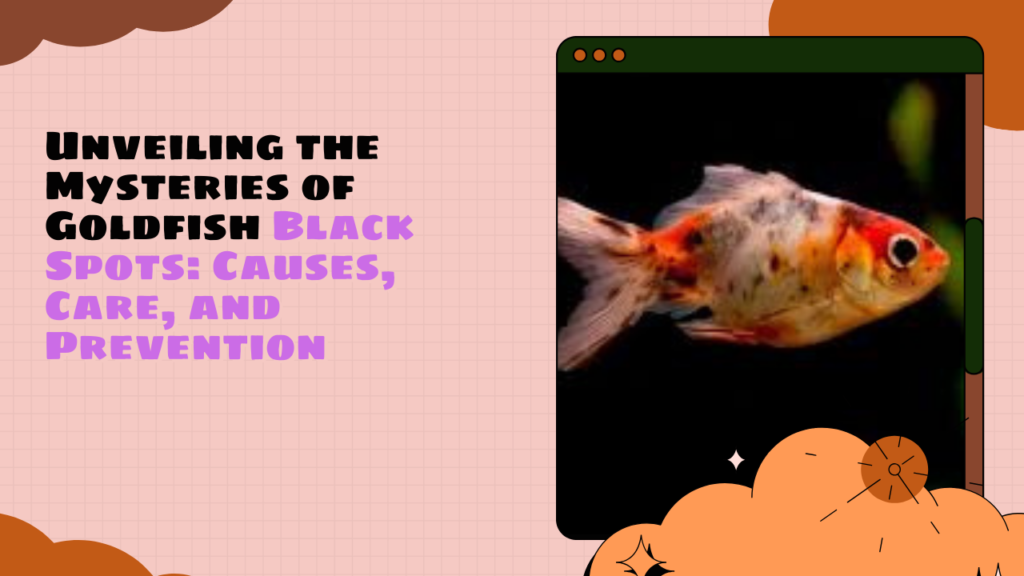Changes in coloration typically bring on Goldfish Black Spots. Age, sun exposure, genetic predispositions, and even specific disorders can cause these patches. In some goldfish breeds, the presence of dark patches may be determined by genetics. Older fish may also have more coloration, especially around their eyes. Sun exposure can cause skin patches to become darker or lighter. Last but not least, black spots might develop due to stress or tissue damage from diseases or traumas.
Main issue: What causes black spots on goldfish? To ensure the health and vitality of these aquatic pets, it is essential to comprehend the causes of these areas.
Table of Contents
- What Are Goldfish Black Spot?
- Causes of Goldfish Black Spots
- Identifying Black Spots
- Goldfish Health and Care
- Preventing Goldfish Black Spots
- Frequently Asked Questions (FAQs)
- Keywords:
What Are Goldfish Black Spot?
In contrast to the rest of their body, a goldfish’s scales, skin, or fins may have pigmented regions called “black spots” that are darker in color. These blemishes may look like distinct black spots or specks. They frequently appear on the head, dorsal region, and along the lateral line, and are most frequently found on or near the scales. These spots can appear more or less frequently in goldfish depending on their age, genetic makeup, and environment. While they may be completely benign, it’s important to keep an eye on their appearance and any changes to guarantee the health of the goldfish.
Causes of Goldfish Black Spots
A. Water Quality
Black spots on goldfish might occur as a result of poor water quality. Polluted water in ponds or aquariums can make goldfish stressed and cause health problems. Black spots could develop as a result of the tension increasing the pigmentation.
Aquariums must be kept clean and maintained frequently to prevent these problems. A goldfish’s aquatic environment must include frequent water changes, effective filtering methods, and suitable oxygenation. Goldfish owners may decrease the chance of black spot growth and enhance the general health of their fish by maintaining crystal-clear water quality.
B. Diet and Nutrition
It is noted that black spots on goldfish might develop when the fish are not receiving appropriate nutrients. Like all other living things, goldfish depend on a balanced diet for good health. When they do not get the necessary nutrients, it can cause nutritional inadequacies, which are frequently reflected in alterations in their coloring, including the emergence of black patches
Owners of goldfish should prioritize feeding their pets high-quality fish food to give optimum nutrition. A great option is goldfish pellets or flakes specially prepared to meet their dietary requirements. Additionally, adding live or frozen delights like brine shrimp or bloodworms to their meal will give diversity and extra nutrients.
A diet with a variety of vegetables, such as spinach, zucchini, or blanched peas, can also benefit. These vegetables offer important vitamins and aid with digestion.
Goldfish owners can help prevent nutritional deficits and lessen the possibility of the development of black spots by providing balanced and nourishing food. This procedure supports the general health of goldfish and keeps their colors vibrant, guaranteeing that these alluring aquatic pets stay in top condition.
C. Stress and Environmental Factors
The occurrence of black spots on goldfish can be significantly influenced by stress and environmental factors. Overcrowding, sudden water quality changes, or exposure to hostile tank mates can all be stressors for goldfish. Increased pigmentation and the appearance of black patches may result from this stress.
- Make sure each fish has a suitable amount of space in their tank to avoid overpopulation. This will help your goldfish feel less stressed.
- Prevent rapid swings in water quality by maintaining consistent water conditions, including temperature, pH, and oxygen levels.
- Carefully choose compatible, non-aggressive tank mates.
To prevent the development of black spots and to improve your goldfish’s general well-being, try to reduce tension and provide a peaceful, stable environment.
Identifying Black Spots
Your goldfish’s overall health needs to identify black spots on them. These spots typically appear in the form of black, pigmented regions on the fish’s scales, skin, or fins that stand out against the goldfish’s body’s paler background. They come in a range of sizes, from specks to huge swaths.
Think about the following to distinguish black spots from other fish conditions:
Texture: Black patches should not have an unusual texture because they are normally pigmented skin areas. If the patches have an odd texture, are elevated, or appear fuzzy, it may be a sign of another skin problem or disease.
Behavior: Keep a close eye on your goldfish. Instead of only having different coloring, the fish may also be in discomfort or have parasites or skin problems if it displays strange habits like rubbing against things or flashing.
Consistency: Pigmentation alterations are probably to blame for black spots that don’t budge and don’t alter in size, shape, or color. However, it’s crucial to seek professional guidance if they seem to expand, spread quickly, or alter in appearance as these could be signs of underlying health issues.
overall health: Pay special attention to your goldfish’s overall well-being. If the fish is energetic, has a healthy appetite, and exhibits no other symptoms of disease, black patches alone might not be cause for alarm. Consult a veterinarian or an expert aquarist for a correct diagnosis, though, if you detect any behavioral changes or other symptoms.
You can give your goldfish the proper care and attention and guarantee their constant well-being by knowing how to notice black spots and differentiate them from other fish conditions.
Goldfish Health and Care
To prevent and treat diseases like black spots, goldfish must be kept in overall good health. Consider the following advice to make sure your goldfish is healthy:
General Goldfish Health
- Offer a well-balanced diet that includes excellent fish food, live or frozen treats, and sporadic vegetables.
- Keep your aquarium clean with frequent water changes and efficient filtration.
- Check the temperature, pH, and ammonia levels of the water and make sure they stay within acceptable standards.
- To lessen stress among goldfish, don’t overcrowd the aquarium.
- Maintain a daily eye out for any behavioral or physical changes in your fish.
- Visit an aquatic veterinarian regularly for checkups to identify any problems early.
Black Spot Treatment
When dealing with black spot goldfish, veterinary advice is necessary. The best course of action might be recommended by the veterinarian after determining the cause of the spots. Dealing with underlying stressors, altering one’s diet, or managing any specific health concerns that are the cause of the pigmentation changes may all be necessary.
It’s imperative to avoid trying to treat yourself without professional aid because poor action may worsen the condition. Consulting a veterinarian makes sure your goldfish will receive the best care that is tailored to their specific needs and supports a rapid and effective recovery.
Preventing Goldfish Black Spots
Maintenance of Water Quality:
To maintain water quality, carry out routine water changes (about 10–20% every 1-2 weeks), use efficient filtration systems, and regularly analyze water parameters including pH, ammonia, and nitrite levels. These procedures help goldfish feel less stressed, which prevents pigmentation changes.
A balanced diet: must be given to prevent black spots through proper eating. Include premium fish food, such as goldfish pellets or flakes, and add brine shrimp and bloodworms as supplements. Occasionally serving veggies like blanched peas will further promote the health of your goldfish.
Stress Reduction: Making a relaxing environment for goldfish is important. This entails keeping the tank free of overcrowding, choosing tank mates who get along with one another, keeping the water level consistent, and providing a well-decorated habitat with hiding places. These actions provide a stress-free environment, reducing the emergence of black spots, and enhancing your goldfish’s general well-being.
Frequently Asked Questions (FAQs)
1 Q: What are the early signs of goldfish black spots?
Small, dark-pigmented areas may begin developing on the scales, skin, or fins as early symptoms of goldfish black spots. These areas are noticeably darker than the fish’s normal coloration and may resemble patches or speckles. It’s essential to keep an eye on these spots since their size, number, or texture changes may point to underlying health problems. Your goldfish’s well-being depends on you acting quickly.
- Q: Can black spots be harmful to my goldfish?
A thorough understanding of the potential risks related to black spots and knowledge of effective mitigation techniques are essential. This knowledge enables you to take immediate action to solve any problems, ensuring the welfare of your goldfish.
.
- Q: How can I maintain the right water quality for my goldfish?
A: Research the best ways to keep the water in your goldfish tank clean and healthy, enhancing their wellbeing and avoiding problems like black spots.
- Q: Are there natural remedies for treating black spots on goldfish?
A: Learn about multiple home treatments and methods that are made from natural ingredients to treat black spots on goldfish. Find out about their particular advantages, how to apply them, and the degree of effectiveness they can offer to support the well-being and energy of your aquatic pals.
- Q: What should I do if my goldfish has black spots?
Discover important things to do if your goldfish starts to exhibit black spots, including determining potential causes, consulting a professional, and modifying care procedures.
Keywords:
- Goldfish black spots
- Causes of black spots on goldfish
- Goldfish care
- Preventing black spots on goldfish
- Goldfish health


